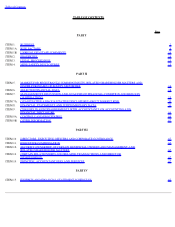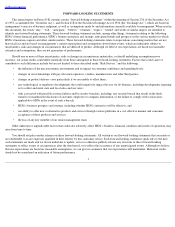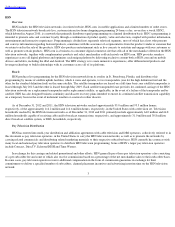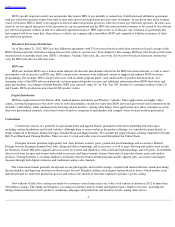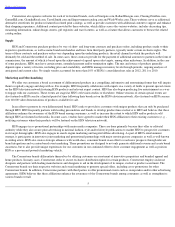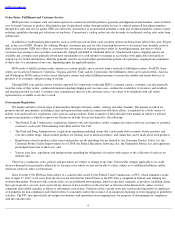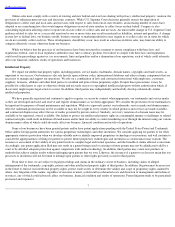Home Shopping Network 2012 Annual Report Download - page 13
Download and view the complete annual report
Please find page 13 of the 2012 Home Shopping Network annual report below. You can navigate through the pages in the report by either clicking on the pages listed below, or by using the keyword search tool below to find specific information within the annual report.
Table of Contents
The risks and uncertainties described below are not the only risks that may have a material adverse effect on HSNi. There exist additional
risks and uncertainties that could adversely affect our business and our results. If any of the following risks actually occur, our business, financial
condition or results of operations could be negatively affected, and the market price for our shares could decline. Further, to the extent that any
of the information contained in this Annual Report on Form 10-K constitutes forward-
looking statements, the risk factors set forth below also are
cautionary statements identifying important factors that could cause the actual results of HSNi to differ materially from those expressed in any
forward-looking statements made by or on behalf of HSNi.
Risks Related to Our Business
Our long-term success depends, in large part, on our continued ability to attract new and retain existing customers in a cost-effective
manner.
In an effort to attract and retain customers, we engage in various marketing and merchandising initiatives, which involve the expenditure
of considerable money and resources, particularly in the case of the production and distribution of HSN television programming and Cornerstone
catalogs. We have spent, and expect to continue to spend, increasing amounts of money on, and devote greater resources to, certain of these
initiatives, particularly in connection with the growth and maintenance of our brands generally, as well as in the continuing efforts of our
businesses to increasingly engage customers through online channels. These initiatives, however, may not resonate with existing customers or
consumers generally or may not be cost-effective. In addition, we believe that costs associated with the production and distribution of HSN
television programming, paper and printing costs for Cornerstone catalogs and costs associated with online marketing, including search engine
marketing (primarily the purchase of relevant keywords) are likely to increase in the foreseeable future and, if significant, could have an adverse
effect on our business, financial condition and results of operations to the extent that they do not result in corresponding increases in sales.
We depend on relationships with pay television operators and adverse changes in these relationships could result in an interruption,
material decrease or even the cessation of carriage of the HSN television networks.
We are dependent upon the pay television operators with whom we enter into distribution and affiliation agreements to carry the HSN
television networks. We currently have contracts with many local and national pay television operators to distribute HSN television
programming. Some of HSN’
s larger pay television operators include Comcast, DirecTV, Echostar/DISH and Time Warner. The two largest pay
television operators represent over 40% of our subscribers. The cessation of carriage of the HSN television networks by a major pay television
operator or a significant number of smaller pay television operators for a prolonged period of time could adversely affect our business, financial
condition and results of operations. While we believe that we will be able to continue to successfully manage the distribution process in the
future, certain changes in distribution levels, as well as increases in commission rates and/or other fees payable for carriage, could occur
notwithstanding these efforts.
We typically seek to enter into long-term distribution and affiliation agreements with these major pay television operators; however, in
some cases, renewals are not agreed upon prior to the expiration of a given agreement and the HSN television networks continue to be carried by
the relevant pay television operator without an effective agreement in place. We currently provide service to approximately 48% of our total
subscribers pursuant to month-to-month contracts or contracts that have expired. In addition, another 35% of our subscribers are represented by
contracts that expire within one year. Renewal and negotiation processes with pay television operators are typically lengthy. No assurance can be
given that we will be successful in negotiating renewals with all these operators or that the financial and other terms of renewal will be on
acceptable terms. The failure to successfully renew or negotiate new distribution and affiliation agreements covering a material portion of these
existing cable and satellite households on acceptable terms could adversely affect our growth, sales revenue and earnings.
Our revenues and profit margin are negatively influenced by economic conditions that impact consumer spending. If macroeconomic
conditions do not continue to improve or if conditions worsen, our business could be adversely affected.
Retailers generally are particularly sensitive to adverse economic and business conditions, in particular to the extent they result in a loss of
consumer confidence, rising unemployment, increased taxes and decreases in consumer spending, particularly discretionary spending. Our
customers anticipate and respond to adverse changes in economic conditions. If macroeconomic conditions do not continue to improve or if
conditions worsen, our business could be adversely affected.
9
ITEM 1A. RISK FACTORS



